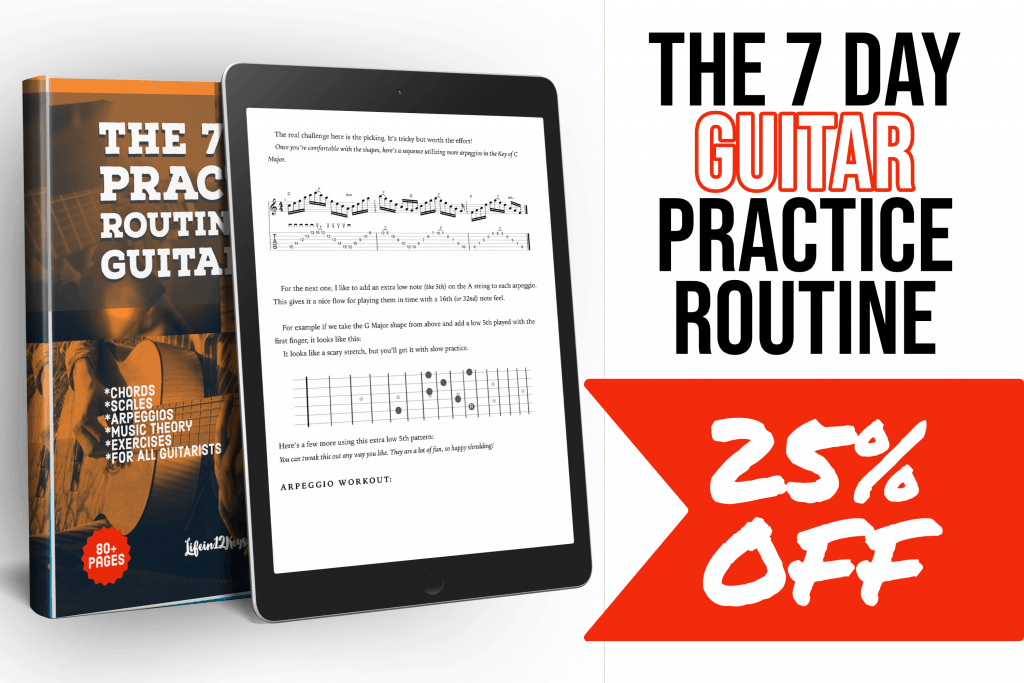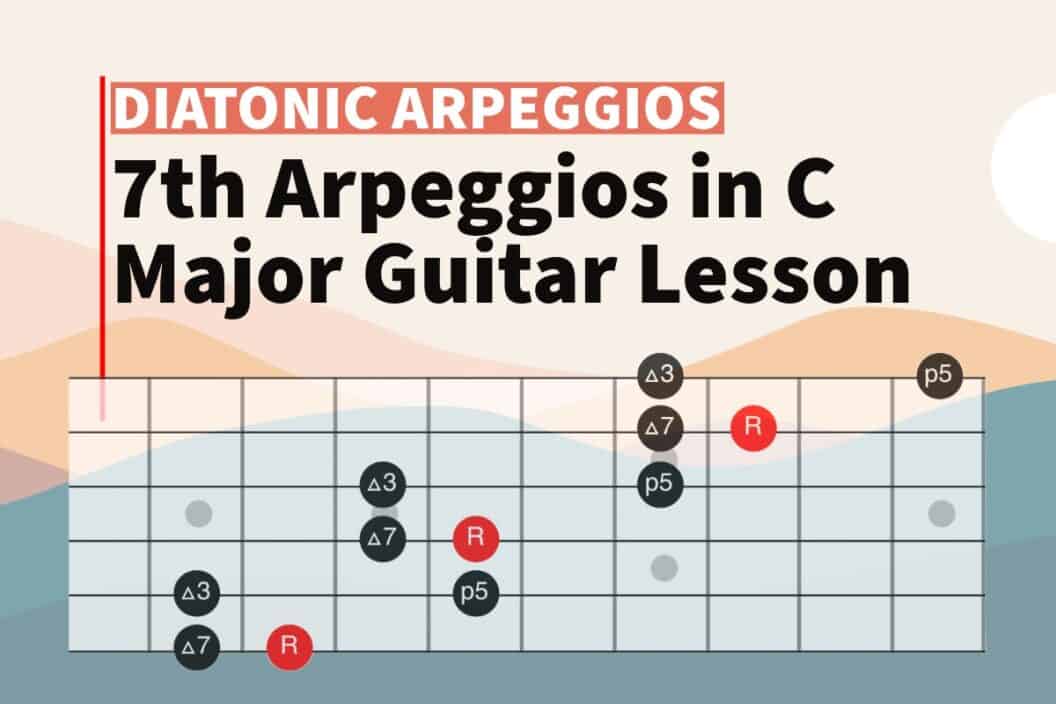Table of Contents
Introduction
Often when I improvise using arpeggios on guitar, I like to add more scale tones to the typical triads or CAGED shape arpeggios in any given key. There a few reasons why you might want to add some extra notes to your arpeggios on the guitar:
- Getting a more focused chord sound. Adding 7ths will drastically change the sound of arpeggios as well as new tonal sounds in the key you’re improvising in.
- Shapes that are just a bit more symmetrical. Shapes that have even amounts of notes and fingerings across strings are easier to memorize.
What is An Arpeggio?
If you need a refresher lesson, I did one a while back on standard diatonic arpeggios for guitar you can check out. Also, I take a deep dive in my 7 Day Practice Routine book.
An arpeggio is a musical term that indicates that notes of a chord are to be played in succession, rather than simultaneously. For example, instead of strumming all of the notes of a chord at once, you play them one after another, either ascending or descending with pick or fingers.
Arpeggios are used in virtually every type of music and played on every musical instrument, most notably the piano, guitar, and violin. They are often used to create a flowing, melodic sound and additionally can add a sense of movement and fluidity to a piece of music. From Classical to Metal and every style in-between, you’ll be sure to find some arpeggios oil virtually every style of music.
Diatonic Arpeggios
Diatonic arpeggios are sequences of notes taken from the parent scale, typically consisting of the 1st (root), 3rd, and 5th notes of the scale, and can also extending to the 7th, 9th, or beyond. The arpeggios below outline the chords naturally found within the key of C Major.

The Formula And Theory For Arpeggios in C Major
I ( C Major): Root, Major 3rd, Perfect 5th (C-E-G)
ii (D Minor): Root, Minor 3rd, Perfect 5th (D-F-A)
iii (E Minor): Root, Minor 3rd, Perfect 5th (E-G-B)
IV (F Major): Root, Major 3rd, Perfect 5th (F-A-C)
V (G Major): Root, Major 3rd, Perfect 5th (G-B-D)
vi (A Minor): Root, Minor 3rd, Perfect 5th (A-C-E)
vii° (B Diminished): Root, Minor 3rd, Diminished 5th (B-D-F)
For us guitar improvisers and aspiring soloists, arpeggios can give us a more focused tonal center by targeting those “good” notes in the chords we’re soloing over. Furthermore, the good news, is there are only 3 shapes to memorize in any given key: Major, minor, and diminished. If you’re already familiar with these shapes and how to apply them, go ahead and skip down the lesson.

minor

diminished

Sweep Picking
Origins of the Sweep Picking Technique: Sweep picking became popular among metal and Neo-Classical guitarists in the 1980s. Sweep picking involves a fluid, sweeping motion with the pick to play multiple strings in quick succession. “Sweeping” allows guitarists to play arpeggios very rapidly, in addition to creating a cascading effect ascending and descending. Some of Sweep picking’s biggest pioneers include Yngwie Malmsteen, Frank Gambale, Bruce Bouilet, and Jason Becker .. consequently, the latter releasing arguably the best instrumental guitar record of the decade “Perpetual Burn“.
Listen, I love me some shredding and sweeping when the mood strikes me, but what about some more practical techniques using alternate picking and some arpeggio shapes that don’t sound so dated or “Classical”. What happens when we add diatonic 7th’s to our existing triads?

In the example above you see I added the diatonic 7th to each triad in C Major. This creates 7 new arpeggios built on each scale tone. An easy way to think of the word diatonic in this application is to think of simply building something off of each existing tone in the scale.
Diatonic 7th Arpeggio Formulas
Adding 7ths to diatonic chords and arpeggios expands the harmonic texture and gives a fuller sense of the underlying chord as well as making for some new and interesting shapes on the guitar. If we expand the above formulas by adding that extra note, we get the following chords:
Major Scale Diatonic Arpeggios with 7ths:
I ( C Major 7): Root, Major 3rd, Perfect 5th, Major 7th (C-E-G-B)
ii (D Minor 7): Root, Minor 3rd, Perfect 5th, minor 7th (D-F-A-C)
iii (E Minor 7): Root, Minor 3rd, Perfect 5th, minor 7th (E-G-B-D)
IV (F Major 7): Root, Major 3rd, Perfect 5th, Major 7th (F-A-C-E)
V (G Dominant 7th): Root, Major 3rd, Perfect 5th (G-B-D-F)
vi (A Minor 7): Root, Minor 3rd, Perfect 5th (A-C-E-G)
vii° (B minor 7th, flat 5th): Root, Minor 3rd, Diminished 5th, flat 7th (B-D-F-A)
Arpeggio Patterns and Fretboard Diagrams for Guitar
Let’s try something a little different. Instead of the boring old CAGED guitar shapes like the ones above, let’s spread these out 2-note-per-string, and over a larger portion of the fretboard. This gives them an almost Pentatonic scale feel but with a richer harmonic structure and sound.
Using 2-note-per-string shapes starting behind the root we get a nice symetrical shape.

This is great shape that falls nicely across the guitar neck using a 1-2-1-4 finger combo that repeats in pairs of 2 strings across 3 octaves.
Now let’s TAB this out:

Notice the alternate picking strokes above. With these 2 note per string shapes, sweep picking isn’t really a practical way to play these. Alternate picking is your friend here, and pay extra close attention to your picking strokes during your practice sessions.
If we continue through the C Major scale to the next note ‘D’ we get a D minor 7th shape.

You can use a 1-2-1-4 or 1-3-1-4 finger combination depending on what’s more comfortable for you.

Remember, we’re just starting a new arpeggio on each note of the C Major scale. So, let’s get the rest of the shapes up:

The fingering here is the same as the last shape.


Another Major 7 arpeggio shape that is exactly like the first one.

Dominant 7 Arpeggio
Our first deviation from standard Major and minor arpeggios in the Key of C. Dominant 7th arpeggios occur on the 5th note of every Major Key.

This new Dominant 7th arpeggio formula creates a new arpeggio shape. This one seems most comfortable using 1-2-1-4 for me. Alternatively, you could try 1-3-1-4 if that is more comfortable.


This minor 7th arpeggio shape is the same as the ones on the 2nd and 3rd degrees of the scale.

Lastly, the Bm7b5, often referred to as “half-diminished” gives are last new and final shape of the key.

This shape feels best played with a 1-3-1-4 finger combo. It also has a nice symmetrical flow across string pairs.

7th Arpeggio Wrap Up
Pretty cool right? Don’t be overwhelmed by all of the shapes at once. Remember, you get 2 of the same Major 7 shapes. We have 3 of the same minor 7, and then 2 remaining rogue shapes that include Dom7 and M7b5. Practice them slowly and remember to pay attention to your alternate picking.
Once you’re comfortable playing them in the key of C, try them in other keys. Also, if you’re up for it, practice these as well as all scales and arpeggios with a metronome!
Here’s a quick audio sample of all 7 arpeggios ascending and descending to get you familiar with sounds of each shape.

Lastly, if you’d like a full, printable PDF of this lesson including Guitar Pro music and audio files, signup for my email list below.
Craig Smith is a professional Guitarist, Teacher, and Writer living in Sanford, Florida. Craig has taught guitar lessons, performed 200+ gigs per year for nearly 30 years, and published 4 guitar instructional books. When he’s not gigging or writing, you may find him by the pool with his wife Celeste, 4 Chihuahuas, and a drink. 🎸


